RedmanWasHere
Rarely in kitchens at parties.
- Aug 23, 2010
- 27,083
- 30,141
- AFL Club
- Essendon
- Other Teams
- Exers, Gryffindor, Rich+Ess AFLW, Tassie
1995: North Melbourne defeated Hawthorn 113-68.
2024: Hawthorn defeated North Melbourne 113-68.
2024: Hawthorn defeated North Melbourne 113-68.







